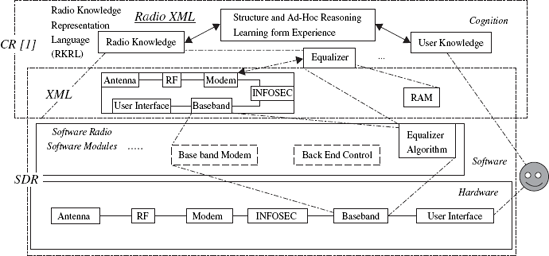7.2. CRA I: Functions, Components and Design Rules
The functions of iCR exceed those of SDR. Reformulating the iCR <Self/> as a peer of its own <User/> establishes the need for added functions by which the <Self/> accurately perceives the local scene including the <User/> and autonomously learns to tailor the information services to the specific <User/> in the current RF and physical <Scene/>.
7.2.1. ICR Functional Component Architecture
The SDR components and the related cognitive components of iCR appear in Figure 7.1. The cognition components describe the SDR in Radio XML so that the <Self/> can know that it is a radio and that its goal is to achieve high QoI tailored to its own users. RXML intelligence includes a priori radio background and user stereotypes as well as knowledge of RF and space-time <Scenes/> perceived and experienced. This includes both structured reasoning with iCR peers and CWNs, and ad hoc reasoning with users, all the while learning from experience.
The detailed allocation of functions to components with interfaces among the components requires closer consideration of the SDR component as the foundation of CRA.
Figure 7.1. The cognitive radio architecture augments software defined radio with computational intelligence and learning capacity. © Dr. Joseph Mitola III, used with permission

7.2.2. SDR Components
SDRs include a hardware platform with RF access ...
Get Cognitive Networks: Towards Self-Aware Networks now with the O’Reilly learning platform.
O’Reilly members experience books, live events, courses curated by job role, and more from O’Reilly and nearly 200 top publishers.

